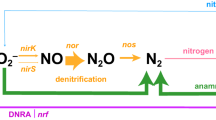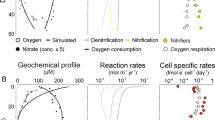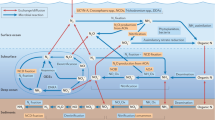Abstract
Numerous biogeochemical reactions occur within the oceans’ major oxygen minimum zones, but less attention has been paid to the open ocean extremities of these zones. Here we report measurements on oxygen minimum zone waters from the Eastern to the Central Tropical North Pacific, which we analysed using metaproteomic techniques to discern the microbial functions present and their influence on biogeochemical cycling. We found nitrite oxidoreductase—an iron-rich enzyme from Nitrospina bacteria—to be one of the most abundant microbial proteins present in the mesopelagic zone, with over 60 billion molecules per litre. Estimated reaction rates imply that this enzyme is undersaturated and that its high abundance provides a latent mesopelagic catalytic capacity to rapidly oxidize nitrite derived from episodic fluxes of degrading sinking organic matter. In addition, given the enzyme’s intensive iron demand, its high abundance represents a previously unrecognized microbial reservoir within suboxic mesopelagic zones. Nitrite oxidoreductase may also contribute to other reactions involving nitrogen and redox-sensitive metals. We suggest that the abundance and extent of nitrite oxidoreductase may increase with continued deoxygenation in the oceans, and result in increased mesopelagic demand for iron and other potential changes to marine biogeochemical cycles.
This is a preview of subscription content, access via your institution
Access options
Access Nature and 54 other Nature Portfolio journals
Get Nature+, our best-value online-access subscription
$29.99 / 30 days
cancel any time
Subscribe to this journal
Receive 12 print issues and online access
$259.00 per year
only $21.58 per issue
Buy this article
- Purchase on Springer Link
- Instant access to full article PDF
Prices may be subject to local taxes which are calculated during checkout





Similar content being viewed by others
Data availability
Environmental data and processed global and targeted metaproteomic results from Metzyme and ProteOMZ expeditions are available at https://www.bco-dmo.org/ under projects 2236 and 685696 and dataset 806510, and the global metaproteomes can be explored through the Ocean Protein Portal (https://www.oceanproteinportal.org). The metagenomic assembly used for peptide-to-spectrum matching is available at NCBI under accession GCA_900411625. Targeted Nxr concentrations and NOB abundances are available within Supplementary Tables 9 and 8. Raw mass spectra are available in PRIDE and ProteomeXchange as project number PXD009712.
References
Moore, J. K., Doney, S. C. & Lindsay, K. Upper ocean ecosystem dynamics and iron cycling in a global three-dimensional model. Global Biogeochem. Cycles 18, GB4028 (2004).
Voss, M. et al. The marine nitrogen cycle: recent discoveries, uncertainties and the potential relevance of climate change. Philos. Trans. R. Soc. B 368, 20130121 (2013).
Watson, S. W. & Waterbury, J. B. Characteristics of two marine nitrite oxidizing bacteria, Nitrospina gracilis nov. gen. nov. sp. and Nitrococcus mobilis nov. gen. nov. sp. Arch. Mikrobiol. 77, 203–230 (1971).
Ward, B. B. et al. Organic carbon, and not copper, controls denitrification in oxygen minimum zones of the ocean. Deep Sea Res. I 55, 1672–1683 (2008).
Imlay, J. A. Iron-sulphur clusters and the problem with oxygen. Mol. Microbiol. 59, 1073–1082 (2006).
Hawley, A. K., Brewer, H. M., Norbeck, A. D., Paša-Tolić, L. & Hallam, S. J. Metaproteomics reveals differential modes of metabolic coupling among ubiquitous oxygen minimum zone microbes. Proc. Natl Acad. Sci. USA 111, 11395–11400 (2014).
Lam, P. et al. Revising the nitrogen cycle in the Peruvian oxygen minimum zone. Proc. Natl Acad. Sci. USA 106, 4752–4757 (2009).
Ward, B., Glover, H. & Lipschultz, F. Chemoautotrophic activity and nitrification in the oxygen minimum zone off Peru. Deep Sea Res. A 36, 1031–1051 (1989).
McCormick, L. R. & Levin, L. A. Physiological and ecological implications of ocean deoxygenation for vision in marine organisms. Philos. Trans. R. Soc. A 375, 20160322 (2017).
Beman, J. M. et al. Global declines in oceanic nitrification rates as a consequence of ocean acidification. Proc. Natl Acad. Sci. USA 108, 208–213 (2010).
Stramma, L., Johnson, G. C., Sprintall, J. & Mohrholz, V. Expanding oxygen-minimum zones in the tropical oceans. Science 320, 655–658 (2008).
Keeling, R. F., Körtzinger, A. & Gruber, N. Ocean deoxygenation in a warming world. Annu. Rev. Mar. Sci. 2, 199–229 (2010).
Deutsch, C., Brix, H., Ito, T., Frenzel, H. & Thompson, L. Climate-forced variability of ocean hypoxia. Science 333, 336–339 (2011).
Fu, W., Primeau, F., Moore, J. K., Lindsay, K. & Randerson, J. T. Reversal of increasing tropical ocean hypoxia trends with sustained climate warming. Global Biogeochem. Cycles 32, 551–564 (2018).
Orsi, W. D. et al. Diverse, uncultivated bacteria and archaea underlying the cycling of dissolved protein in the ocean. ISME J. 10, 2158–2173 (2016).
Rafter, P. A. & Sigman, D. M. Spatial distribution and temporal variation of nitrate nitrogen and oxygen isotopes in the upper equatorial Pacific Ocean. Limnol. Oceanogr. 61, 14–31 (2016).
Barber, R. T. et al. Primary productivity and its regulation in the equatorial Pacific during and following the 1991–1992 El Niño. Deep Sea Res. II 43, 933–969 (1996).
Coale, K. H., Fitzwater, S. E., Gordon, R. M., Johnson, K. S. & Barber, R. T. Control of community growth and export production by upwelled iron in the equatorial Pacific Ocean. Nature 379, 621–624 (1996).
Johnson, G. C., McPhaden, M. J. & Firing, E. Equatorial Pacific Ocean horizontal velocity, divergence, and upwelling. J. Phys. Oceanogr. 31, 839–849 (2001).
Rafter, P. A., Sigman, D. M., Charles, C. D., Kaiser, J. & Haug, G. H. Subsurface tropical Pacific nitrogen isotopic composition of nitrate: biogeochemical signals and their transport. Global Biogeochem. Cycles 26, GB1003 (2012).
Gruber, N. & Sarmiento, J. L. Global patterns of marine nitrogen fixation and denitrification. Global Biogeochem. Cycles 11, 235–266 (1997).
Deutsch, C., Gruber, N., Key, R. M., Sarmiento, J. L. & Ganachaud, A. Denitrification and N2 fixation in the Pacific Ocean. Global Biogeochem. Cycles 15, 483–506 (2001).
Cline, J. & Kaplan, I. Isotopic fractionation of dissolved nitrate during denitrification in the eastern tropical North Pacific Ocean. Mar. Chem. 3, 271–299 (1975).
Saito, M. A. et al. Needles in the blue sea: sub-species specificity in targeted protein biomarker analyses within the vast oceanic microbial metaproteome. Proteomics 15, 3521–3531 (2015).
Scott, K. B., Turko, I. V. & Phinney, K. W. Quantitative performance of internal standard platforms for absolute protein quantification using multiple reaction monitoring-mass spectrometry. Anal. Chem. 87, 4429–4435 (2015).
Lücker, S., Nowka, B., Rattei, T., Spieck, E. & Daims, H. The genome of Nitrospina gracilis illuminates the metabolism and evolution of the major marine nitrite oxidizer. Front. Microbiol. 4, 27 (2013).
Santoro, A. E., Casciotti, K. L. & Francis, C. A. Activity, abundance and diversity of nitrifying archaea and bacteria in the central California Current. Environ. Microbiol. 12, 1989–2006 (2010).
Füssel, J. et al. Nitrite oxidation in the Namibian oxygen minimum zone. ISME J. 6, 1200–1209 (2012).
Stewart, F. J., Ulloa, O. & DeLong, E. F. Microbial metatranscriptomics in a permanent marine oxygen minimum zone. Environ. Microbiol. 14, 23–40 (2012).
Ngugi, D. K., Blom, J., Stepanauskas, R. & Stingl, U. Diversification and niche adaptations of Nitrospina-like bacteria in the polyextreme interfaces of Red Sea brines. ISME J. 10, 1383–1399 (2016).
Spieck, E., Ehrich, S., Aamand, J. & Bock, E. Isolation and immunocytochemical location of the nitrite-oxidizing system in Nitrospira moscoviensis. Arch. Microbiol. 169, 225–230 (1998).
Saito, M. A. et al. Multiple nutrient stresses at intersecting Pacific Ocean biomes detected by protein biomarkers. Science 345, 1173–1177 (2014).
Yin, J., Overpeck, J., Peyser, C. & Stouffer, R. Big jump of record warm global mean surface temperature in 2014–2016 related to unusually large oceanic heat releases. Geophys. Res. Lett. 45, 1069–1078 (2018).
Meincke, M., Bock, E., Kastrau, D. & Kroneck, P. M. Nitrite oxidoreductase from Nitrobacter hamburgensis: redox centers and their catalytic role. Arch. Microbiol. 158, 127–131 (1992).
Ohnemus, D. C. et al. Elevated trace metal content of prokaryotic communities associated with marine oxygen deficient zones. Limnol. Oceanogr. 62, 3–25 (2017).
Collier, R. W. Molybdenum in the Northeast Pacific Ocean 1. Limnol. Oceanogr. 30, 1351–1354 (1985).
Santoro, A. et al. Measurements of nitrite production in and around the primary nitrite maximum in the central California Current. Biogeosciences 10, 7395–7410 (2013).
Spieck, E. et al. Two-dimensional structure of membrane-bound nitrite oxidoreductase from Nitrobacter hamburgensis. J. Struct. Biol. 117, 117–123 (1996).
Füssel, J. et al. Adaptability as the key to success for the ubiquitous marine nitrite oxidizer Nitrococcus. Sci. Adv. 3, e1700807 (2017).
Lücker, S. et al. A Nitrospira metagenome illuminates the physiology and evolution of globally important nitrite-oxidizing bacteria. Proc. Natl Acad. Sci. USA 107, 13479–13484 (2010).
Buchwald, C. & Casciotti, K. L. Isotopic ratios of nitrite as tracers of the sources and age of oceanic nitrite. Nat. Geosci. 6, 308–313 (2013).
Buchwald, C., Santoro, A. E., Stanley, R. H. & Casciotti, K. L. Nitrogen cycling in the secondary nitrite maximum of the eastern tropical North Pacific off Costa Rica. Global Biogeochem. Cycles 29, 2061–2081 (2015).
Rue, E. R., Smith, G. J., Cutter, G. A. & Bruland, K. W. The response of trace element redox couples to suboxic conditions in the water column. Deep Sea Res. II 44, 113–134 (1997).
Moffett, J. W., Goepfert, T. J. & Naqvi, S. W. A. Reduced iron associated with secondary nitrite maxima in the Arabian Sea. Deep Sea Res. I 54, 1341–1349 (2007).
Munson, K. M., Lamborg, C. H., Swarr, G. J. & Saito, M. A. Mercury species concentrations and fluxes in the Central Tropical Pacific Ocean. Global Biogeochem. Cycles 29, 656–676 (2015).
Jacob, J. et al. Oxidation kinetics and inverse isotope effect of marine nitrite-oxidizing isolates. Aquat. Microb. Ecol. 80, 289–300 (2017).
Nowka, B., Daims, H. & Spieck, E. Comparison of oxidation kinetics of nitrite-oxidizing bacteria: nitrite availability as a key factor in niche differentiation. Appl. Environ. Microbiol. 81, 745–753 (2015).
Santoro, A. E. et al. Thaumarchaeal ecotype distributions across the equatorial Pacific Ocean and their potential roles in nitrification and sinking flux attenuation. Limnol. Oceanogr. 62, 1984–2003 (2017).
Zakem, E. J. et al. Ecological control of nitrite in the upper ocean. Nat. Commun. 9, 1206 (2018).
Bristow, L. A. et al. Ammonium and nitrite oxidation at nanomolar oxygen concentrations in oxygen minimum zone waters. Proc. Natl Acad. Sci. USA 113, 10601–10606 (2016).
Granger, J. & Ward, B. B. Accumulation of nitrogen oxides in copper limited cultures of denitrifying bacteria. Limnol. Oceanogr. 48, 313–318 (2003).
Jacquot, J. E. et al. Assessment of the potential for copper limitation of ammonia oxidation by Archaea in a dynamic estuary. Mar. Chem. 162, 37–49 (2014).
Suzuki, I., Sugiyama, T. & Omata, T. Primary structure and transcriptional regulation of the gene for nitrite reductase from the cyanobacterium Synechococcus PCC 7942. Plant Cell Physiol. 34, 1311–1320 (1993).
Chisholm, S. W., Falkowski, P. & Cullen, J. J. Dis-crediting ocean fertilization. Science 294, 309–310 (2001).
Santoro, A. E., Buchwald, C., McIlvin, M. R. & Casciotti, K. L. Isotopic signature of N2O produced by marine ammonia-oxidizing archaea. Science 333, 1282–1285 (2011).
Hughes, C. S. et al. Ultrasensitive proteome analysis using paramagnetic bead technology. Mol. Syst. Biol. 10, 757 (2014).
Brownridge, P. J., Harman, V. M., Simpson, D. M. & Beynon, R. J. in Quantitative Methods in Proteomics (ed. Marcus, K.) 267–293 (Springer, 2012).
Saito, M. A. et al. Needles in the blue sea: sub-species specificity in targeted protein biomarker analyses within the vast oceanic microbial metaproteome. Proteomics 15, 3521–3531 (2015).
Lu, X. & Zhu, H. Tube-gel digestion. Mol. Cell. Proteom. 4, 1948–1958 (2006).
Tanaka, Y., Fukumori, Y. & Yamanaka, T. Purification of cytochrome a 1c 1 from Nitrobacter agilis and characterization of nitrite oxidation system of the bacterium. Arch. Microbiol. 135, 265–271 (1983).
Dupont, C. L. et al. Genomes and gene expression across light and productivity gradients in eastern subtropical Pacific microbial communities. ISME J. 9, 1076–1092 (2015).
Sigman, D. et al. A bacterial method for the nitrogen isotopic analysis of nitrate in seawater and freshwater. Anal. Chem. 73, 4145–4153 (2001).
Casciotti, K. L., Sigman, D. M., Hastings, M. G., Böhlke, J. K. & Hilkert, A. Measurement of the oxygen isotopic composition of nitrate in seawater and freshwater using the denitrifier method. Anal. Chem. 74, 4905–4912 (2002).
Noble, A. E. et al. Basin-scale inputs of cobalt, iron, and manganese from the Benguela-Angola front into the South Atlantic Ocean. Limnol. Oceanogr. 57, 989–1010 (2012).
Hawco, N. J., Ohnemus, D. C., Resing, J. A., Twining, B. S. & Saito, M. A. A dissolved cobalt plume in the oxygen minimum zone of the eastern tropical South Pacific. Biogeosciences 13, 5697–5717 (2016).
Westley, M. B., Yamagishi, H., Popp, B. N. & Yoshida, N. Nitrous oxide cycling in the Black Sea inferred from stable isotope and isotopomer distributions. Deep Sea Res. II 53, 1802–1816 (2006).
Acknowledgements
We thank the captain and crews of the RV Kilo Moana and RV Falkor for their assistance. We appreciate the sampling assistance from T. Goepfert, N. Held, N. Hawco, T. Horner, C. Hau, and D. Wang. Metagenome and N. marina sequencing was provided by the Department of Energy Joint Genome Institute. Time aboard the RV Falkor was provided by the Schmidt Ocean Institute. Funding for this research in the Saito laboratory was provided by the Gordon and Betty Moore Foundation (3782) and the National Science Foundation (OCE-1031271, 1736599, 1657766, 1850719, 1924554). J.K.S. was supported by the NASA Postdoctoral Fellowship Program. A.E.S. was supported by the Sloan Foundation, the Simons Foundation and United States National Science Foundation award OCE-1437310. A portion of this research used resources at the DOE Joint Genome Institute sponsored by the Office of Biological and Environmental Research and operated under contract DE-AC02-05CH11231 (JGI). C.L.D. and D.K. were supported by NSF grant OCE-1259994.
Author information
Authors and Affiliations
Contributions
M.A.S. led field expeditions, collected samples, analysed datasets and wrote the manuscript. M.R.M. analysed samples by mass spectrometry and developed targeted proteomic assays. D.M.M. collected and extracted metaproteomic samples. A.E.S. participated in the expeditions, contributed to interpretations, measured NOB abundances, cultured Nb-295 and edited the manuscript. C.L.D. analysed metagenomics datasets, provided metagenomic assemblies and contributed to the manuscript. P.A.R. analysed 15N-NO3 samples and contributed to the manuscript discussion. J.K.S. contributed to metaproteomic informatic analyses and manuscript interpretations. D.K. contributed to metagenomic informatic analyses. M.W. contributed N2O and nitrite data from KM0405. C.H.L. co-led the Metzyme field expedition, collected samples and contributed to the manuscript discussions. J.B.W. and F.V. contributed to nitrifier culture experiments and manuscript discussions.
Corresponding author
Ethics declarations
Competing interests
The authors declare no competing interests.
Additional information
Peer review information Primary Handling Editor: Rebecca Neely.
Publisher’s note Springer Nature remains neutral with regard to jurisdictional claims in published maps and institutional affiliations.
Supplementary information
Supplementary Information
Supplementary Tables 1–9, Figs. 1–28 and references.
Rights and permissions
About this article
Cite this article
Saito, M.A., McIlvin, M.R., Moran, D.M. et al. Abundant nitrite-oxidizing metalloenzymes in the mesopelagic zone of the tropical Pacific Ocean. Nat. Geosci. 13, 355–362 (2020). https://doi.org/10.1038/s41561-020-0565-6
Received:
Accepted:
Published:
Issue Date:
DOI: https://doi.org/10.1038/s41561-020-0565-6
This article is cited by
-
Persistent equatorial Pacific iron limitation under ENSO forcing
Nature (2023)
-
Mineral-catalysed formation of marine NO and N2O on the anoxic early Earth
Nature Geoscience (2022)
-
The marine nitrogen cycle: new developments and global change
Nature Reviews Microbiology (2022)
-
Marine plankton metabolisms revealed
Nature Microbiology (2021)
-
Substantial oxygen consumption by aerobic nitrite oxidation in oceanic oxygen minimum zones
Nature Communications (2021)



